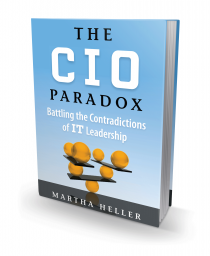I don’t often read books about IT leadership because I find that most try to fit business principles into technology and vice versa. The square peg into a round hole dilemma.
So when Martha Heller approached me to read an advanced copy of her new book The CIO Paradox: Battling the Contradictions of IT Leadership it felt more like homework. I am thought to myself here is yet another step‑by‑step guide. And that is where I was wrong – very wrong.
For those of you who are not familiar with Martha; for over a decade, she has established herself as a figure in IT leadership. She is President of Heller Search Associates, a Boston-based firm specializing in recruiting CIOs and other IT executives across multiple industries. She is probably best known as a Founder and Managing Director of CIO magazine’s CIO Executive Council, a professional organization for CIOs. It was here that she developed leadership programs for CIOs and directed the CIO Best Practice Exchange, a member-only network of CIOs from top-tier organizations. She continues to engage with CIO audiences through CIO Paradox column, as author of CIO.com’s Movers & Shakers blog, and author of You and Your CIO, a blog on CFO.com.
As a CIO for some time, I often read articles and books but never anything that truly captures the essence of what it means to be a CIO. Does this sound familiar:
- “Your many successes are invisible; your few mistakes are highly visible.”
- “You were hired to be strategic, but spend most of your time on operational issues.”
- “You are the steward of risk mitigation and cost containment, yet you are expected to innovate.”
- “IT can make or break a company, but CIOs rarely sit on corporate boards.”
- “You develop successors, yet the CEO almost always goes outside to find the next CIO.”
- “Technology is a long-term investment, but the company thinks in quarters.”
In the book, Martha posits the collection of CIO paradoxes into four larger categories addressing the multi-faceted influence CIOs have on a company. Below are some of the key paradoxes influencing companies today through the perspective of IT executives that Martha has talked with:
1. The CIO Role: You’re Damned If You Do, and You’re Damned If You Don’t
The mindset surrounding how the CIO should function is based on traditional approaches that limit true innovation. For example, our current era grants CIOs the opportunity to drive serious breakthroughs, but this prospect does not decrease the need for cost efficiencies.
2. The Stakeholders: Will the Business Ever Love IT?
As the business and employees get smarter about technology, the more they dislike IT. This is seen when CIOs are intimately involved in every facet of the business, yet they often don’t get a seat at the table.
3. The CIO’s Staff: They Just Don’t Make Them Like That
Recruiting and developing a core of well-rounded IT professionals is laden with structural obstacles and unrealistic expectations. When a rapidly developing field such as technology hasn’t evolved its recruitment process since the dot-com bust, you know there’s a problem.
4. The Future: What’s Next for the CIO?
The forecast of current and future CIOs is a multidimensional one that can negotiate assumptions for demand. A clear example of this is when the CIO role meets many of the specialties a corporate board values, yet CIOs are rarely appointed a seat.
The CIO Paradox is a book for the everyday CIO. The CIO who is in the trenches dealing with these paradoxes each and everyday. It is a good read with just the right amount of humor and wit to engage and captivate. This is not average boring IT book….


Arun, thanks for reading The CIO Paradox and for this review!